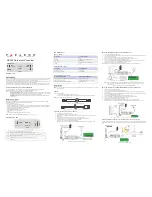
Introduction
2
Manual Documentation Number: PES1A/PESV1A-0712m
B&B Electronics Mfg Co Inc – 707 Dayton Rd - PO Box 1040 - Ottawa IL 61350 - Ph 815-433-5100 - Fax 815-433-5104 –
www.bb-elec.com
B&B Electronics Ltd – Westlink Commercial Park – Oranmore, Galway, Ireland – Ph +353 91-792444 – Fax +353 91-792445 –
www.bb-europe.com
10/100 Mbps auto-detecting operation
IEEE 802.3af (Power over Ethernet) compatible
Web Configuration and Management user interface
Email event notification
Communication Modes
PES1A/PESV1A Ethernet to RS-232 converters
allow you to connect
serial devices over a LAN or WAN. Serial devices no longer are limited to a
physical connection to the PC COM port. They can be installed anywhere on
the LAN using TCP/IP or UDP/IP communications. This allows traditional
Windows PC software access to serial devices anywhere on the LAN/WAN
network.
Direct IP
Direct IP Mode
allows applications using TCP/IP or UDP/IP socket
programs to communicate with the asynchronous serial ports on the serial
server. In this mode the PES1A/PESV1A is configured as a TCP or UDP
server. The socket program running on the PC establishes a communication
connection. The data is sent directly to and from the serial port on the server.
TCP Server Mode
allows network devices to initiate a TCP connection to
the serial device connected to the serial port on the PES1A/PESV1A. This is
also referred to as reverse telnet.
UDP Server Mode
allows network devices to initiate a UDP connection to
the serial device attached to the serial port of the PES1A/PESV1A. When
using UDP protocol the PES1A/PESV1A can be configured to broadcast data
to and receive data from multiple IP addresses.
Virtual COM Port
Virtual COM Port
mode (also called RealPort, or com port redirection)
allows you to map a COM port on your PC to the serial port on your
PES1A/PESV1A. Using the RealPort software
(included with the
PES1A/PESV1A) you create virtual COM ports on your PC. When your
application sends data to this port, RealPort redirects the data across the
network to serial device connected to the PES1A/PESV1A serial port. The
network is transparent to the user application and the serial device connected
to the PES1A/PESV1A.













































